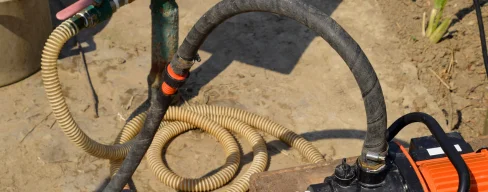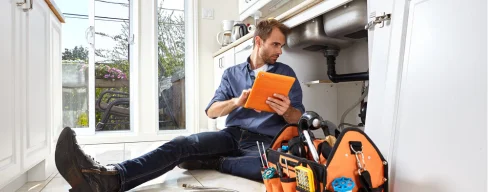While winter is known for its scenic beauty, it also brings along a set of common challenges, and one such issue is the occurrence of frozen pipes. When the mercury dips, water within your plumbing can freeze, leading to the pipes becoming fragile and, in more extreme instances, rupturing. To avoid the potentially expensive and bothersome consequences of this situation, it’s vital to quickly find a frozen pipe in your residence. In this article, we will provide you with a comprehensive guide on how to find a frozen pipe promptly within your household.
Check for Reduced Water Flow
The most common sign of a frozen pipe is reduced water flow. If you happen to observe that your faucets or showerheads are delivering a mere trickle of water or have ceased functioning altogether, there is a strong likelihood that a frozen pipe is lurking somewhere in your plumbing system.
Inspecting for diminished water flow represents a fundamental step if you want to find frozen pipe within your residence and the need for measures on how to find frozen pipe. When a pipe is exposed to freezing temperatures, it constricts the passage of water and causes in a prominent lowering in water pressure, and sometimes a complete termination of water flow.
To decide the issue “how to find a frozen pipe”, you need to activate various faucets and fixtures throughout your home, in the kitchen, bathroom, and any other areas supplied with running water. Don’t overlook the necessity to evaluate the water flow in your shower or bathtub.
Vigilantly monitor the water flow emanating from each faucet and fixture. Are you detecting a notable decline in water pressure compared to the usual output, or is it evident that only a feeble trickle of water is emerging from these sources? When water flow exhibits a significant reduction or has altogether ceased, this serves as a clear and indicative sign that a frozen pipe may be the culprit and you need to understand how to find a frozen pipe.
To answer the question “How to find frozen water pipe and to pinpoint the frozen pipe’s location”, compare the water flow in different areas of your house. If one specific area has a noticeably weaker water flow compared to the rest of the house, it’s likely to find a frozen pipe in that vicinity.
Check both cold and hot water pipes to ensure that the issue isn’t limited to just one temperature. Frozen pipes can impact both the hot and cold water supply lines, so conducting tests on both can assist to gauge the full scope of the issue and find frozen water pipes.
One of the steps of the process “How to find a frozen pipe” is the next. As you monitor water flow, keep your ears open for any atypical noises, like bubbling or gurgling.
These noises can indicate that water is having difficulty passing through a frozen section of the pipe.
If you suspect a particular area might have a frozen pipe, try running water in a sequential manner. Turn on the faucet or fixture closest to the suspected frozen pipe and gradually move away from it, checking the water flow at each location. This can help you narrow down the exact spot of the blockage and find frozen water pipe.
When checking for reduced water flow, refrain from using excessive force to open faucets or fixtures. Applying too much pressure can cause additional stress on the frozen pipe and potentially lead to a burst pipe. So, it’s important to be careful when you try to find frozen pipe.
To find frozen pipe please keep in mind that recognizing a decrease in water flow is merely one of the indicators pointing to a frozen pipe issue. If you have reason to believe that a frozen pipe may be lurking in your home, it’s imperative to find frozen water pipe and act swiftly to avert additional damage. The strategies detailed in this article, including scrutinizing for frost on exposed pipes and investigating for leaks, can be employed to verify the existence of a frozen pipe and deal with the problem effectively.
Listen for Unusual Sounds
If you find a frozen pipe, you may hear strange sounds coming from your plumbing system. These sounds can include gurgling, clanking, or even hissing as water struggles to pass through the frozen section. Pay close attention to your pipes, especially in quiet moments, to detect these noises.
Look for Frost on Visible Pipes
Inspect any visible pipes in your home, such as those in the basement, attic, or crawl spaces to find frozen water pipes. Frost or ice on the outside of the pipes is a clear indication of freezing. Not all pipes are easily visible, so you need to investigate further.
Check the Temperature
One of the methods of how to find frozen pipe is the next. You can use a thermometer to measure the temperature in the area where you suspect a frozen pipe. Pipes can freeze in an extremely cold environment. The below-freezing temperature in the location of the suspected frozen pipe can be a reason for the possibility of a frozen pipe.
Open Cabinet Doors
In some cases, pipes can freeze in kitchen or bathroom cabinets. Open the cabinet doors and feel for cold spots. If you notice a particular section of a cabinet that is much colder than the rest, it may be due to a frozen pipe nearby.
Call a Professional
If you’re unable to find a frozen pipe or cannot safely thaw it yourself, it’s time to call a professional plumber. Plumbers have the necessary expertise and equipment to find frozen pipes and prevent them from causing further damage to your home.
Calling a professional plumber is a crucial step when you need to find a frozen pipe in your house. You can take some initial steps to identify and possibly thaw a frozen pipe yourself, but there are situations where professional intervention is necessary.
You can start by researching local plumbing services to find a reputable and experienced plumber. Consider consulting with people you know, like friends, family, or neighbors who may have encountered similar problems, or explore the internet to discover plumbing firms that have received favorable feedback and high ratings. When contacting a plumber, be sure to provide a comprehensive account of the issue, clearly stating your need to locate a frozen pipe within your residence and furnishing any pertinent details, such as the symptoms you’ve noticed and the specific area of concern. If the frozen pipe issue is urgent, you can inquire about the plumbing service that offers emergency or 24/7 services.
Many plumbing companies offer 24/7 emergency services, which can be especially valuable in harsh weather conditions when frozen pipes are prone to causing issues, necessitating a swift response to find frozen water pipes. When you speak with the plumber, it’s important to share important information about your home’s size, plumbing system’s age, and other pertinent details to help them prepare for their visit. After identifying the frozen pipe, the plumber will suggest a course of action. This might involve thawing the pipe, making necessary repairs, or offering advice on how to prevent future freezing issues. They can provide guidance on insulation, temperature maintenance, and other preventive measures.
Сalling a professional plumber is a prudent step when you don’t know how to find frozen pipe in your home, especially if you’re unsure about how to safely and effectively resolve the issue. Professional plumbers have the expertise, tools, and experience to diagnose and address frozen pipe problems while minimizing potential damage to your plumbing system and property.
Dealing with frozen pipes can be a frustrating and costly ordeal, but with the right knowledge of how to find frozen pipe and prompt action, you can mitigate the potential damage. By remaining vigilant for indicators such as reduced water pressure, unusual noises, frost accumulation on exposed pipes, and similar cues, it’s crucial to learn how to detect frozen water pipes within your home and promptly address them to avert potential plumbing crises. Engaging the services of a skilled plumber is a wise choice to address the problem with expertise and ensure a safe and efficient resolution.
Contact Details
Email: info@drainexpress.ca
Phone:
+1 416 752 5959
Our Location
300 New Toronto St #14,
Etobicoke, ON, M8V 2E8
24/h Customer Service
We are open 24/7
Contact us at any time

